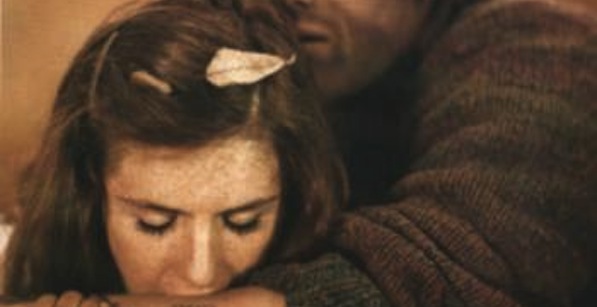Nominated for the Palme d’or, Andrzej Wajda’s Landscape After Battle made a splash upon its premiere at the 1970 Cannes Film Festival. The Polish Cultural Institute offers this description of the film:
Landscape After Battle opens with one of the most celebrated sequences in Wajda’s work: liberated by the arrival of American troops, the prisoners in a concentration camp stream out of their confines, smash the windows of their barracks, strip and throw their striped uniforms into a roaring fire. Those moments of unimaginable freedom quickly lead to the realization that most have nowhere to go. Their former prison becomes their “displaced persons” camp. Tadeusz (Daniel Olbrychski, and never better), an intellectual whose main interest is recovering his books, feels as alienated from his fellow prisoners as he did from his captors. But then he forms a tenuous bond with Nina (Stanislawa Celinska), a young Jewish woman who lost everything and everyone in the war.
Looking at some of the reviews from the time of the film’s release (posted on Wajda’s website), the film’s political content was of utmost interest. Warsaw critic Waldemar Cholodoswki remarked that the film amounts to an “arena of a raging debate about the significance of such notions as homeland, country, nation; a debate as important today as it was in 1945:”
Is the homeland synonymous with a trolley loaded with books, a commonwealth of language, landscapes remembered from childhood “transfused into the bloodstream” as Tadeusz would have it, or does the homeland cease to have any significance, when one cannot find one’s place in it, as Nina discovers through her very existence?
What matters for Tadeusz is a country of landscapes of all the battles: won, lost, and still continuing. Wajda, who created this beautiful tale about human beings, seems to share his hero’s opinion.
Italian critic Dario Zanelli connected the film’s depiction of the Americans who helped liberate Poland in World War II with the Russians who occupied Poland during at the time of the film’s release:
The whole film is fraught with a powerful, desperate and disillusioned love of the homeland; it justifies deep pessimism as a painful experience of various forms of external suppression and internal conflict. The liberation of Poland doesn’t bring freedom from this suffering. The Americans of 1945 are like the Russians of yesterday and today: the Poles’ “freedom under surveillance” continues – Andrzej Wajda reminds us bitterly.
Warsaw critic Melchior Wankowicz was taken by the film’s depiction of love:
The surrealist picture of two naked bodies rolling on the ground, where the cover of dead leaves hides sharp twigs and stones which wound and hurt both lovers, might be symbolic of the pain that accompanies liberation, but is this symbol presented by Wajda intentionally? (…)
This beautiful symbol of love can also represent human trash from the barracks. The superficial humiliation will be cast off, but will the lovers be illuminated by a creative flame? (…) I believe this is Wajda’s main concern and in this he is not alone. He has behind him the tradition of our greatest artists.
Forty years later, how does the film’s content and Wajda’s artistry hold up? Quite well, according to Acquarello’s review found in the indispensible Strictly Film School:
Landscape After the Battle is a poignant, caustic, and resigned portrait of despair, cultural estrangement, and alienation of Poland’s postwar generation. Using recurrent images of confinement, encircling camerawork, and incongruous and unusual imagery, Andrzej Wajda reflects the pervasive sense of inertia, anguish, and pessimism of a displaced generation compelled to live in extended exile as their nation struggles to rebuild under the turbulent and uncertain era of a Russian controlled, newly communist Poland: the forbidding barbed wire fences, gated walls, and trenches of the German resettlement camp; the lifeless and surreal reenactment of the patriotic Battle of Grunwald; the emotionally conflicted shot of a church memorial wall dedicated to German military casualties… Through repeated patterns of inhumanity, degradation, and barbarism, Wajda provides an incisive commentary and a cautionary tale for the suppression of personal freedom and the propagation of a destructive ideology that rationalizes the practice of internment in the distrustful atmosphere of the Cold War – Poland’s figurative landscape after the battle – an alien and oppressive environment of demoralization, human cruelty, and moral decay.




